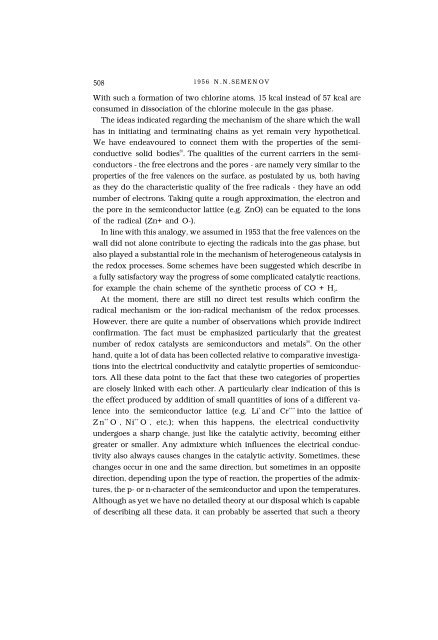Nikolai N. Semenov - Nobel Lecture - Nobelprize.org
Nikolai N. Semenov - Nobel Lecture - Nobelprize.org
Nikolai N. Semenov - Nobel Lecture - Nobelprize.org
You also want an ePaper? Increase the reach of your titles
YUMPU automatically turns print PDFs into web optimized ePapers that Google loves.
508 1956 N.N.SEMENOV<br />
With such a formation of two chlorine atoms, 15 kcal instead of 57 kcal are<br />
consumed in dissociation of the chlorine molecule in the gas phase.<br />
The ideas indicated regarding the mechanism of the share which the wall<br />
has in initiating and terminating chains as yet remain very hypothetical.<br />
We have endeavoured to connect them with the properties of the semiconductive<br />
solid bodies 55 . The qualities of the current carriers in the semiconductors<br />
- the free electrons and the pores - are namely very similar to the<br />
properties of the free valences on the surface, as postulated by us, both having<br />
as they do the characteristic quality of the free radicals - they have an odd<br />
number of electrons. Taking quite a rough approximation, the electron and<br />
the pore in the semiconductor lattice (e.g. ZnO) can be equated to the ions<br />
of the radical (Zn+ and O-).<br />
In line with this analogy, we assumed in 1953 that the free valences on the<br />
wall did not alone contribute to ejecting the radicals into the gas phase, but<br />
also played a substantial role in the mechanism of heterogeneous catalysis in<br />
the redox processes. Some schemes have been suggested which describe in<br />
a fully satisfactory way the progress of some complicated catalytic reactions,<br />
for example the chain scheme of the synthetic process of CO + H 2<br />
.<br />
At the moment, there are still no direct test results which confirm the<br />
radical mechanism or the ion-radical mechanism of the redox processes.<br />
However, there are quite a number of observations which provide indirect<br />
confirmation. The fact must be emphasized particularly that the greatest<br />
number of redox catalysts are semiconductors and metals 56 . On the other<br />
hand, quite a lot of data has been collected relative to comparative investigations<br />
into the electrical conductivity and catalytic properties of semiconductors.<br />
All these data point to the fact that these two categories of properties<br />
are closely linked with each other. A particularly clear indication of this is<br />
the effect produced by addition of small quantities of ions of a different valence<br />
into the semiconductor lattice (e.g. Li + and Cr +++ into the lattice of<br />
Zn ++ O -- , Ni ++ O -- , etc.); when this happens, the electrical conductivity<br />
undergoes a sharp change, just like the catalytic activity, becoming either<br />
greater or smaller. Any admixture which influences the electrical conductivity<br />
also always causes changes in the catalytic activity. Sometimes, these<br />
changes occur in one and the same direction, but sometimes in an opposite<br />
direction, depending upon the type of reaction, the properties of the admixtures,<br />
the p- or n-character of the semiconductor and upon the temperatures.<br />
Although as yet we have no detailed theory at our disposal which is capable<br />
of describing all these data, it can probably be asserted that such a theory
















